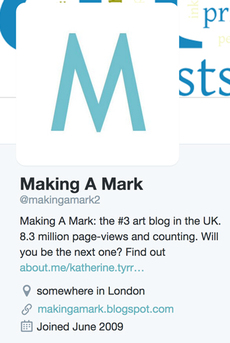- Home
- NEWS
-
PRACTICE
-
MARKETING
- How to write an Artist's Statement >
- How to write an Artist's Resume or CV >
- How to sign a painting, drawing or fine art print
- Business Cards for Artists
- How to write a press release for an artist
- The Private View Invitation
- Publicity for Juried Exhibitions
- Websites for Artists >
- Image & Video sizes for Social Media Sites
- How to be mobile-friendly
-
SELL ART
- FRAME ART
-
SHIP ART
-
COPYRIGHT
-
MONEY & TAX
- About + Help
- BANKING
How do you describe yourself as an artist on social media?
More and more artists are learning about
how to use social media to promote their art and themselves as an artist
Don't leave a gap where the bio should be because you don't know where to start - read on!
how to use social media to promote their art and themselves as an artist
Don't leave a gap where the bio should be because you don't know where to start - read on!
Key Points
|
Benefits of working on social media bios
|
|
|
|
Personal profiles are for non-commercial use and represent individual people. You can follow profiles to see public updates from people you're interested in but aren't friends with. Pages look similar to personal profiles, but they offer unique tools for businesses, brands and organizations. Pages are managed by people who have personal profiles. Your summary on Facebook is:
REFERENCE
|
REFERENCE
YouTubeIf you're not camera shy, one of the best ways to introduce who you are is to make a mini-video of yourself explaining who you are, what you do and the purpose of your channel.
|
Tips about Images (Dimensions)
|
In creating social media profiles I used to find few things more irritating than uploading an image to social media and finding that it doesn't look anything like you intended - because of the constraints on the pixels and picture ratio.
That's why I now have a yellow post it note on the desktop of my computer which has the optimal sizes for the images used by different parts of social media. In this section I'll list some of the detailed constraints and measurements. Note they are in PIXELS and you need an image editor that can crop in pixels. |
See also Image Sizes for Social Media Sites
|
ABOUT ART BUSINESS INFO. FOR ARTISTS
This website aims to provide a compendium of resources about the art business for artists. Please read "PLEASE NOTE"
It helps artists learn how to do better at being business-like, marketing and selling their art and looking after their financial security.
This website aims to provide a compendium of resources about the art business for artists. Please read "PLEASE NOTE"
It helps artists learn how to do better at being business-like, marketing and selling their art and looking after their financial security.
|
Copyright: 2015-2021 Katherine Tyrrell | Making A Mark Publications
- all rights reserved If you've got any suggestions for what you'd like to see on this website please send me your suggestion
|
PLEASE NOTE:
1) Content and the law change all the time. It's impossible to keep up with it if you're not working on the topic full time. 2) I research topics carefully. However, I am totally unable to warrant that ANY and/or ALL information is
|
3) Hence all information I provide comes without any LIABILITY whatsoever to you for any choices you make.
4) This website is FREE FOR YOU but not for me. Links to books are Amazon Affiliate links. Buying a book via this website means I get a very small payment which helps to fund and maintain this website. .I much appreciate any support your provide. Adverts are provided by Google AdSense - but the adverts do not mean I endorse the advertiser. |
- Home
- NEWS
-
PRACTICE
-
MARKETING
- How to write an Artist's Statement >
- How to write an Artist's Resume or CV >
- How to sign a painting, drawing or fine art print
- Business Cards for Artists
- How to write a press release for an artist
- The Private View Invitation
- Publicity for Juried Exhibitions
- Websites for Artists >
- Image & Video sizes for Social Media Sites
- How to be mobile-friendly
-
SELL ART
- FRAME ART
-
SHIP ART
-
COPYRIGHT
-
MONEY & TAX
- About + Help
- BANKING
